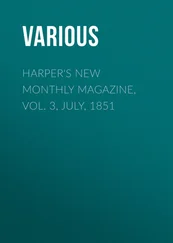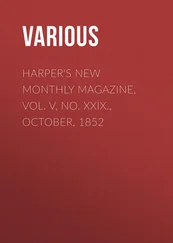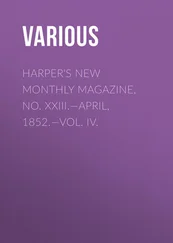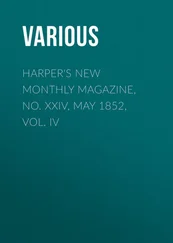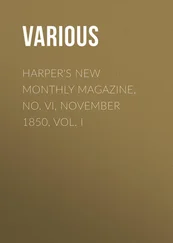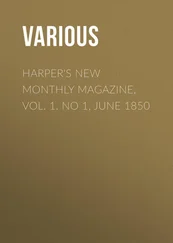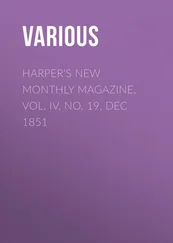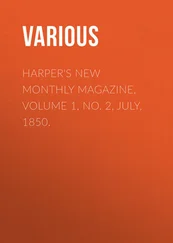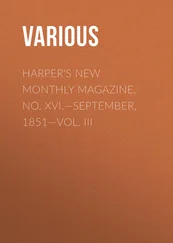Various - Harper's New Monthly Magazine, No. XXVI, July 1852, Vol. V
Здесь есть возможность читать онлайн «Various - Harper's New Monthly Magazine, No. XXVI, July 1852, Vol. V» — ознакомительный отрывок электронной книги совершенно бесплатно, а после прочтения отрывка купить полную версию. В некоторых случаях можно слушать аудио, скачать через торрент в формате fb2 и присутствует краткое содержание. Издательство: Иностранный паблик, Жанр: periodic, foreign_edu, на английском языке. Описание произведения, (предисловие) а так же отзывы посетителей доступны на портале библиотеки ЛибКат.
- Название:Harper's New Monthly Magazine, No. XXVI, July 1852, Vol. V
- Автор:
- Издательство:Иностранный паблик
- Жанр:
- Год:неизвестен
- ISBN:нет данных
- Рейтинг книги:4 / 5. Голосов: 1
-
Избранное:Добавить в избранное
- Отзывы:
-
Ваша оценка:
- 80
- 1
- 2
- 3
- 4
- 5
Harper's New Monthly Magazine, No. XXVI, July 1852, Vol. V: краткое содержание, описание и аннотация
Предлагаем к чтению аннотацию, описание, краткое содержание или предисловие (зависит от того, что написал сам автор книги «Harper's New Monthly Magazine, No. XXVI, July 1852, Vol. V»). Если вы не нашли необходимую информацию о книге — напишите в комментариях, мы постараемся отыскать её.
Harper's New Monthly Magazine, No. XXVI, July 1852, Vol. V — читать онлайн ознакомительный отрывок
Ниже представлен текст книги, разбитый по страницам. Система сохранения места последней прочитанной страницы, позволяет с удобством читать онлайн бесплатно книгу «Harper's New Monthly Magazine, No. XXVI, July 1852, Vol. V», без необходимости каждый раз заново искать на чём Вы остановились. Поставьте закладку, и сможете в любой момент перейти на страницу, на которой закончили чтение.
Интервал:
Закладка:
Various
Harper's New Monthly Magazine, No. XXVI, July 1852, Vol. V
THE ARMORY AT SPRINGFIELD
SPRINGFIELD
The Connecticut river flows through the State of Massachusetts, from north to south, on a line about half way between the middle of the State and its western boundary. The valley through which the river flows, which perhaps the stream itself has formed, is broad and fertile, and it presents, in the summer months of the year, one widely extended scene of inexpressible verdure and beauty. The river meanders through a region of broad and luxuriant meadows which are overflowed and enriched by an annual inundation. These meadows extend sometimes for miles on either side of the stream, and are adorned here and there with rural villages, built wherever there is a little elevation of land – sufficient to render human habitations secure. The broad and beautiful valley is bounded on either hand by an elevated and undulating country, with streams, mills, farms, villages, forests, and now and then a towering mountain, to vary and embellish the landscape. In some cases a sort of spur or projection from the upland country projects into the valley, forming a mountain summit there, from which the most magnificent views are obtained of the beauty and fertility of the surrounding scene.
There are three principal towns upon the banks of the Connecticut within the Massachusetts lines: Greenfield on the north – where the river enters into Massachusetts from between New Hampshire and Vermont – Northampton at the centre, and Springfield on the south. These towns are all built at points where the upland approaches near to the river. Thus at Springfield the land rises by a gentle ascent from near the bank of the stream to a spacious and beautiful plain which overlooks the valley. The town is built upon this declivity. It is so enveloped in trees that from a distance it appears simply like a grove with cupolas and spires rising above the masses of forest foliage; but to one within it, it presents every where most enchanting pictures of rural elegance and beauty. The streets are avenues of trees. The houses are surrounded by gardens, and so enveloped in shrubbery that in many cases they reveal themselves to the passer-by only by the glimpse that he obtains of a colonnade or a piazza, through some little vista which opens for a moment and then closes again as he passes along. At one point, in ascending from the river to the plain above, the tourist stops involuntarily to admire the view which opens on either side, along a winding and beautiful street which here crosses his way. It is called Chestnut-street on the right hand, and Maple-street on the left – the two portions receiving their several names from the trees with which they are respectively adorned. The branches of the trees meet in a dense and unbroken mass of foliage over the middle of the street, and the sidewalk presents very precisely the appearance and expression of an alley in the gardens of Versailles.
THE ARMORY GROUNDS
On reaching the summit of the ascent, the visitor finds himself upon an extended plain, with streets of beautiful rural residences on every hand, and in the centre a vast public square occupied and surrounded by the buildings of the Armory. These buildings are spacious and elegant in their construction, and are arranged in a very picturesque and symmetrical manner within the square, and along the streets that surround it. The grounds are shaded with trees; the dwellings are adorned with gardens and shrubbery. Broad and neatly-kept walks, some graveled, others paved, extend across the green or along the line of the buildings, opening charming vistas in every direction. All is quiet and still. Here and there a solitary pedestrian is seen moving at a distance upon the sidewalk, or disappearing among the trees at the end of an avenue; and perhaps the carriage of some party of strangers stands waiting at a gate. The visitor who comes upon this scene on a calm summer morning, is enchanted by the rural beauty that surrounds him, and by the air of silence and repose which reigns over it all. He hears the distant barking of a dog, the voices of children at play, or the subdued thundering of the railway-train crossing the river over its wooden viaduct, far down the valley – and other similar rural sounds coming from a distance through the calm morning air – but all around him and near him is still. Can it be possible, he asks, that such a scene of tranquillity and loveliness can be the outward form and embodiment of a vast machinery incessantly employed in the production of engines of carnage and death?
It is, however, after all, perhaps scarcely proper to call the arms that are manufactured by the American government, and stored in their various arsenals, as engines of carnage and destruction. They ought, perhaps, to be considered rather as instruments of security and peace; for their destination is, as it would seem, not to be employed in active service in the performance of the function for which they are so carefully prepared; but to be consigned, when once finished, to eternal quiescence and repose. They protect by their existence, and not by their action; but in order that this, their simple existence, should be efficient as protection, it is necessary that the instruments themselves should be fitted for their work in the surest and most perfect manner. And thus we have the very singular and extraordinary operation going on, of manufacturing with the greatest care, and with the highest possible degree of scientific and mechanical skill, a vast system of machinery, which, when completed, all parties concerned most sincerely hope and believe will, in a great majority of cases, remain in their depositories undisturbed forever. They fulfill their vast function by their simple existence – and thus, though in the highest degree useful, are never to be used.
THE BUILDINGS
The general appearance of the buildings of the Armory is represented in the engraving placed at the head of this article. The point from which the view is taken, is on the eastern side of the square – that is, the side most remote from the town. The level and extended landscape seen in the distance, over the tops of the buildings, is the Connecticut valley – the town of Springfield lying concealed on the slope of the hill, between the buildings and the river. The river itself, too, is concealed from view at this point by the masses of foliage which clothe its banks, and by the configuration of the land.
The middle building in the foreground, marked by the cupola upon the top of it, is called the Office. It contains the various counting-rooms necessary for transacting the general business of the Armory, and is, as it were, the seat and centre of the power by which the whole machinery of the establishment is regulated. North and south of it, and in a line with it, are two shops, called the North and South Filing Shops, where, in the several stories, long ranges of workmen are found, each at his own bench, and before his own window, at work upon the special operation, whatever it may be, which is assigned to him. On the left of the picture is a building with the end toward the observer, two stories high in one part, and one story in the other part. The higher portion – which in the view is the portion nearest the observer – forms the Stocking Shop, as it is called; that is the shop where the stocks are made for the muskets, and fitted to the locks and barrels. The lower portion is the Blacksmith's Shop. The Blacksmith's Shop is filled with small forges, at which the parts of the lock are forged. Beyond the Blacksmith's Shop, and in a line with it, and forming, together with the Stocking Shop and the Blacksmith's Shop, the northern side of the square, are several dwelling-houses, occupied as the quarters of certain officers of the Armory. The residence of the Commanding Officer, however, is not among them. His house stands on the west side of the square, opposite to the end of the avenue which is seen opening directly before the observer in the view. It occupies a very delightful and commanding situation on the brow of the hill, having a view of the Armory buildings and grounds upon one side, and overlooking the town and the valley of the Connecticut on the other.
Читать дальшеИнтервал:
Закладка:
Похожие книги на «Harper's New Monthly Magazine, No. XXVI, July 1852, Vol. V»
Представляем Вашему вниманию похожие книги на «Harper's New Monthly Magazine, No. XXVI, July 1852, Vol. V» списком для выбора. Мы отобрали схожую по названию и смыслу литературу в надежде предоставить читателям больше вариантов отыскать новые, интересные, ещё непрочитанные произведения.
Обсуждение, отзывы о книге «Harper's New Monthly Magazine, No. XXVI, July 1852, Vol. V» и просто собственные мнения читателей. Оставьте ваши комментарии, напишите, что Вы думаете о произведении, его смысле или главных героях. Укажите что конкретно понравилось, а что нет, и почему Вы так считаете.

